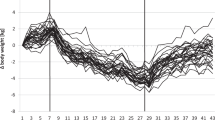Abstract
We assessed the reproducibility of ad libitum energy intake (EI) in overweight/obese subjects. A total of six men and two women, with a body mass index 27–32 kg/m2, aged 18–45 years, not currently dieting and weight stable during the past 3 months were studied. Participants’ EI before the study was standardized. A 1047 kJ (250 kcal) liquid preload containing 40% energy from whey protein (that is, 25 g of whey protein isolate) or a non-energy control preload were consumed randomly 90 min before an ad libitum lunch meal. Participants completed visual analogue scales for subjective appetite after preloads, and reported food intake during the remainder of the day. Treatments were repeated twice to assess reproducibility of ad libitum EI. Mean ad libitum EI was 3811±979 kJ and 3334±719 kJ after control- and whey protein-containing preloads, respectively. Analysis of repeated treatments showed within-treatment mean differences (± s.d.; day 1 minus day 2) of −50±251 kJ (−12±60 kcal), within coefficient of variation (CV) of 4.5% and intraclass correlation of 0.97 for control preloads. These results were −142±544 kJ ( 34±130 kcal), within-subject CVs of 11.2% and intraclass correlations of 0.72 for whey protein-containing preloads. In conclusion, ad libitum EI in a laboratory study using the preload paradigm in overweight and obese subjects was highly reproducible.
This is a preview of subscription content, access via your institution
Access options
Subscribe to this journal
Receive 12 print issues and online access
$259.00 per year
only $21.58 per issue
Buy this article
- Purchase on Springer Link
- Instant access to full article PDF
Prices may be subject to local taxes which are calculated during checkout


Similar content being viewed by others
References
Akhavan T, Luhovyy BL, Brown PH, Cho CE, Anderson GH (2010). Effect of premeal consumption of whey protein and its hydrolysate on food intake and postmeal glycemia and insulin responses in young adults. Am J Clin Nutr 91, 966–975.
Arvaniti K, Richard D, Tremblay A (2000). Reproducibility of energy and macronutrient intake and related substrate oxidation rates in a buffet-type meal. Br J Nutr 83, 489–495.
Bellissimo N, Thomas SG, Pencharz PB, Goode RC, Anderson GH (2008). Reproducibility of short-term food intake and subjective appetite scores after a glucose preload, ventilation threshold, and body composition in boys. Appl Physiol Nutr Metab 33, 326–337.
Bowen J, Noakes M, Trenerry C, Clifton PM (2006). Energy intake, ghrelin, and cholecystokinin after different carbohydrate and protein preloads in overweight men. J Clin Endocrinol Metab 91, 1477–1483.
Gregersen NT, Flint A, Bitz C, Blundell JE, Raben A, Astrup A (2008). Reproducibility and power of ad libitum energy intake assessed by repeated single meals. Am J Clin Nutr 87, 1277–1281.
Nair NS, Brennan IM, Little TJ, Gentilcore D, Hausken T, Jones KL et al. (2009). Reproducibility of energy intake, gastric emptying, blood glucose, plasma insulin and cholecystokinin responses in healthy young males. Br J Nutr 101, 1094–1102.
Norton GN, Anderson AS, Hetherington MM (2006). Volume and variety: relative effects on food intake. Physiol Behav 87, 714–722.
Obarzanek E, Levitsky DA (1985). Eating in the laboratory: is it representative? Am J Clin Nutr 42, 323–328.
Yeomans MR (2000). Rating changes over the course of meals: what do they tell us about motivation to eat? Neurosci Biobehav Rev 24, 249–259.
Acknowledgements
This research was supported by a research grant from Mars Inc.
Author information
Authors and Affiliations
Corresponding author
Ethics declarations
Competing interests
The authors declare no conflict of interest.
Rights and permissions
About this article
Cite this article
Lara, J., Taylor, M. & Macdonald, I. Is ad libitum energy intake in overweight subjects reproducible in laboratory studies using the preload paradigm?. Eur J Clin Nutr 64, 1028–1031 (2010). https://doi.org/10.1038/ejcn.2010.104
Received:
Revised:
Accepted:
Published:
Issue Date:
DOI: https://doi.org/10.1038/ejcn.2010.104
Keywords
This article is cited by
-
Sex as an independent variable in the measurement of satiation: a retrospective cohort study
International Journal of Obesity (2022)



